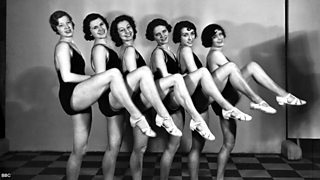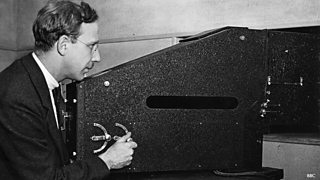
The Paramount Astoria Girls were among the artists to appear on screen as the ЦчІҐґуРг took charge of TV
22nd August is the anniversary of the day in 1932 when television transmissions by the low-definition, 30-line Baird process began to be devised and produced by the ЦчІҐґуРг – when ЦчІҐґуРг television proper was born.
Previous broadcasts were under the control of the Baird Television Co. Ltd. ‘at whose disposal the ЦчІҐґуРг placed its transmitters in the interest of experiment’. The London National wavelength (261.3 metres) and the Midland Regional wavelength (398.9 metres)
Starting on 30th September 1929, the Baird Television Company had . At first only one transmitter was available, on top of Selfridges in Oxford Street, so programmes consisted of two minute chunks of vision followed by two minutes of sound, the whole programmes lasting half an hour. After five months, a second transmitter was brought into service so that sound and vision could be transmitted simultaneously (which must have been a relief to all concerned). Some sources quote the date for this advance as 30th March 1930, but this was a Sunday on which no television transmissions took place (and would not until 1938).
At 11am on Monday 31st March 1930 the went out (although Radio Times states that this transmission was on 261.3 metres only…) Sadly at the moment there seems to be no record surviving of who took part in the programme. The ЦчІҐґуРг did not publish such details in Radio Times, presumably because artists were contracted by the Baird Company, although some newspapers did give details.
The first date for which any artist details are available is 10th April 1930, when the Daily Mirror reported that the performers would be soubrette Ouida MacDermott, soprano Gwen Stella, and Lulu Stanley. Miss Stanley, a singer (billed elsewhere as a soubrette and dancer), had also taken part (unbilled) in the first official transmission on 30th September 1929. As with all transmissions under the auspices of the Baird Company, other than the occasional press report afterwards, it’s hard to be certain that the artists billed actually did take part – unless anyone out there has a relative who watched and took notes…?

Baird 30-scanners were installed in a basement room in the new Broadcasting House
There were after 17th June and until 22nd August 1932 while the ЦчІҐґуРг took over, although Radio Times still billed transmissions until 1st July.
As the ЦчІҐґуРг assumed production duties, Baird technicians installed equipment in a basement room of the newly opened Broadcasting House. Studio BB was supposed to be the band room for the ЦчІҐґуРг Dance Orchestra, but they had to make other arrangements, to their chagrin. After a year and a half, new premises were found for television, at 16 Langham Place.
This was not however the first occasion on which the ЦчІҐґуРг had co-operated with Baird on programmes. In July 1930, the first official television play had been broadcast, starring Earle Grey (replacing the billed Val Gielgud) and Lionel Millard. The play, written by Luigi Pirandello, was adapted and produced by the ЦчІҐґуРг’s Lance Sieveking, in association with the Baird Company’s Sydney Moseley.
On 7th December 1931, a by Edith Lake (violoncello) and Kathleen Cooper (pianoforte) was televised, this was primarily a radio programme on the Daventry National Programme (long wave), with the vision on the London National Programme and sound on London Regional (both medium wave). This was unusual because television was usually confined to periods when normal radio broadcasts were not going out. Nonetheless, a further ten such simulcasts took place from 19th December 1931 until 18th April 1932.
It’s hard to tell without further research (watch this space) whether these involved radio or television doing an outside broadcast, but both were capable of the feat in theory – though it might have been easier for radio to do it as they had more experience. Baird had managed to televise street scenes in May 1931, and the Derby on 3rd June, but whether the Baird technicians were able to install their equipment in a ЦчІҐґуРг sound studio is a moot point.
The relationship between Baird and the ЦчІҐґуРг had not been an easy one, and would continue to have its difficulties. On the one side Baird and his allies felt that the ЦчІҐґуРг did not do enough to promote their work, on the other the ЦчІҐґуРг’s engineers were sceptical of the technical quality of the pictures, and the chances of the Baird system ever producing a service worthy of subsidy from the licence fee.
There were impartial sceptics too, aware of development work going on in electronic television, and knowing that mechanical systems like Baird’s had inherent limitations – true high definition television would never be possible, despite Baird’s headline-grabbing innovations such as colour, stereoscopic tv, large screen tv, and video recording. The contracts between the ЦчІҐґуРг and Baird were always limited in term, and there was always the looming possibility that superior systems would emerge, as they did by the mid-30s.
